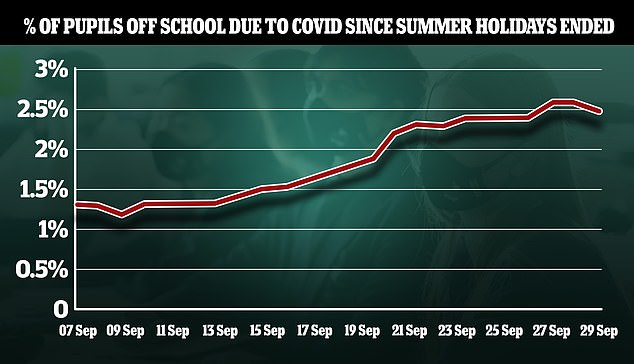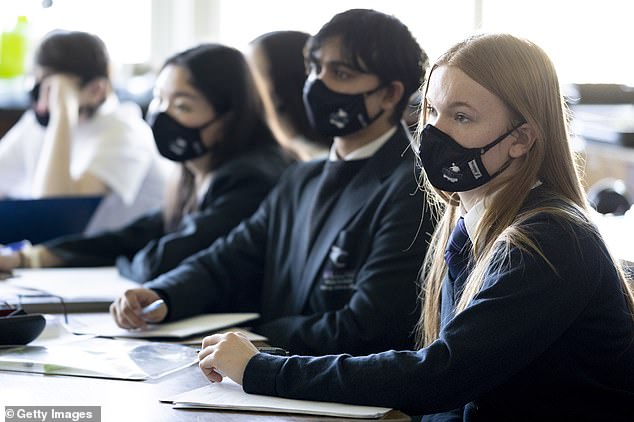The number of children forced to miss school due to Covid has nearly doubled since the start of the new term, official data shows.
One in forty pupils were absent in England last Thursday, up from around one in 80 on September 7.
The 204,000 who missed class were off either because they had Covid themselves or were identified as a close contact of a positive case.
Teaching unions blamed the ‘grim statistics’ on high Covid rates in schools and urged new Education Secretary Nadhim Zahawi to get a grip on the crisis.
Children between the age of 10 and 19, who are largely unvaccinated, are currently recording up to 15 times more Covid cases than older adults.
Some schools have started to take matters into their own hands, with councils ordering them to bring back a suite of stricter Covid curbs.
The Department for Education (DfE) estimated that 2.5 per cent of all pupils were not in class for reasons connected to coronavirus on Thursday last week.
This is up from the 1.3 per cent of all pupils, on September 7, a week after schools went back at the start of the month.

One in forty pupils (2.5 per cent) — at least one child in every two classes — were absent in England last Thursday, up from around one in 80 (1.3 per cent) on September 7

One in forty pupils — at least one child in every two classes — were absent in England last Thursday due to Covid (file)
The figures include 102,000 pupils with a confirmed case of Covid and 84,100 with a suspected case. About 11,400 were absent due to isolation for other reasons.
A further 4,800 were off due to attendance restrictions being in place to manage an outbreak and 2,000 did not attend as a result of school closures due to Covid.
Geoff Barton, general secretary of the Association of School and College Leaders (ASCL), said the ‘grim statistics show a big increase in the number of pupils out of school as a result of the continuing havoc caused by coronavirus.
Hundreds of schools are told to be ‘proactive’ and bring back suite of Covid curbs
Schools have been instructed by councils to bring in a suite of stricter Covid curbs in response to rising infections among pupils.
Hundreds of primaries and secondaries in Staffordshire were urged to be ‘proactive’ and not wait on official guidance from the Government.
The county’s council has encouraged bringing back face masks and year group bubbles and scrapping assemblies and staff meetings. It also recommended schools stagger starting and break times to limit mixing in corridors and the playground.
Staffordshire County Council, which covers more than 400 schools, is believed to be the first to promote reintroducing such a comprehensive set of measures.
Other local authorities have brought back light measures like mask-wearing, including Cumbria and parts of Northamptonshire.
Pupils whose family member tests positive are advised to ‘stay at home pending PCR test result’, despite the fact schools can’t legally make them isolate.
Ministers scrapped the requirement for all contacts of Covid cases to self-isolate in August.
Advertisement
‘We are hearing from schools where there are 10 per cent or more of pupils absent and where staff are also off work because of the virus.
‘Teaching and learning is very difficult in these circumstances and it is clear that the educational disruption of the past 18 months is far from being over.’
Mr Barton has called on the new Education Secretary to urgently set out what action he intends to take to address the situation.
He added: ‘One thing he might do is to look at why it is taking so long to deliver the carbon dioxide monitors to schools that the Government promised at the start of term.’
Schools in England no longer have to keep pupils in year group ‘bubbles’ to reduce mixing, and children do not have to isolate if they come into contact with a positive case of Covid.
Instead, they are advised to get a PCR test and only isolate if they test positive.
A DfE spokeswoman said: ‘We are committed to protecting education, which is why the safety measures in place strike a balance between managing transmission risk with regular testing and enhanced ventilation and hygiene, and reducing disruption to face-to-face education.
‘We are working with parents and school and college staff to maximise students’ time in the classroom – encouraging uptake of testing and the vaccine for 12 to 15-year-olds, and contracting specialist attendance advisers to work on strategies to improve attendance where problems are identified.’
Data from the Government’s Covid dashboard shows 10 to 14-year-olds have the highest infection rate in England at 1,500 per 100,000 people. Older teens have a rate of around 600.
For comparison, age groups over 70s have a rate of around 100 while for the middle-aged it varies between 200 and 400.
It comes after hundreds of primary and secondary schools in Staffordshire were urged to be ‘proactive’ and not wait on official guidance from the Government.
The county’s council has encouraged bringing back face masks and year group bubbles and scrapping assemblies and staff meetings.
It also recommended schools stagger starting and break times to limit mixing in corridors and the playground.
Staffordshire County Council, which covers more than 400 schools, is believed to be the first to promote reintroducing such a comprehensive set of measures.
Other local authorities have brought back light measures like mask-wearing, including Cumbria and parts of Northamptonshire.
Pupils whose family member tests positive are advised to ‘stay at home pending PCR test result’, despite the fact schools can’t legally make them isolate.
Ministers scrapped the requirement for all contacts of Covid cases to self-isolate in August.
Source link : https://www.dailymail.co.uk/news/article-10061563/One-40-children-200-000-school-England-Covid-week.html











